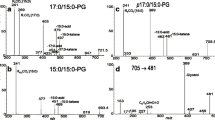Abstract
Lipopolysaccharides (LPSs, endotoxins) are components of the outer cell membrane of most Gram-negative bacteria and can play an important role in a number of diseases of bacteria, including Gram-negative sepsis. The hydrophilic carbohydrate part of LPSs consists of a core oligosaccharide (in the case of an R-type LPS or lipooligosaccharide, LOS) linked to an O-polysaccharide chain (in the case of an S-type LPS), which is responsible for O-specific immunogenicity. The hydrophobic lipid A anchor is composed of a phosphorylated diglucosamine backbone to which varying numbers of ester- and amide-linked fatty acids are attached and this part of the LPSs is associated with endotoxicity. The detailed chemical characterization of endotoxins requires long-lasting large-scale isolation procedures, by which high-purity LPSs can be obtained. However, when a large number of bacterial samples and their LPS content are to be compared prompt, small-scale isolation methods are used for the preparation of endotoxins directly from bacterial cell cultures. The purity of the endotoxins extracted by these methods may not be high, but it is sufficient for analysis.
Here, we describe a fast and easy micromethod suitable for extracting small quantities of LOS and a slightly modified micromethod for the detection of the lipid A constituents of the LPSs from bacteria grown in different culture media and evaluate the structures with mass spectrometry. The cellular LOS and lipid A were obtained from crude isolates of heat-killed cells, which were then subjected to matrix-assisted laser desorption/ionization mass spectrometry analysis. The observed ions in the 10-colony samples were similar to those detected for purified samples. The total time for the sample preparation and the MS analysis is less than 3 h.
Access this chapter
Tax calculation will be finalised at checkout
Purchases are for personal use only
Similar content being viewed by others
References
Rietschel ET, Brade H (1992) Bacterial endotoxins. Sci Am 267:54–61
Galanos C, Lüderitz O, Westphal O (1969) A new method for extraction of R-lipopolysaccharides. Eur J Biochem 9:245–249
Westphal O, Lüderitz O, Bister F (1952) Über Die Extraktion Von Bakterien Mit Phenol Wasser. Z Naturforsch B 7:148–155
Nummila K, Kilpelainen I, Zähringer U, Vaara M, Helander IM (1995) Lipopolysaccharides of polymyxin B-resistant mutants of Escherichia coli are extensively substituted by 2-aminoethyl pyrophosphate and contain aminoarabinose in lipid A. Mol Microbiol 16:271–278
Hitchcock PJ, Brown TM (1983) Morphological heterogeneity among Salmonella lipopolysaccharide chemotypes in silver-stained polyacrylamide gels. J Bacteriol 154:269–277
Thérisod H, Labas V, Caroff M (2001) Direct microextraction and analysis of rough-type lipopolysaccharides by combined thin-layer chromatography and MALDI mass spectrometry. Anal Chem 73:3804–3807
Yi EC, Hackett M (2000) Rapid isolation method for lipopolysaccharide and lipid A from Gram-negative bacteria. Analyst 125:651–656
El Hamidi A, Tirsoaga A, Novikov A, Hussein A, Caroff M (2005) Microextraction of bacterial lipid A: easy and rapid method for mass spectrometric characterization. J Lipid Res 46:1773–1778
Zhou P, Chandan V, Liu X, Chan K, Altman E, Li J (2009) Microwave assisted sample preparation for rapid and sensitive analysis of H. pylori lipid A applicable to a single colony. J Lipid Res 50:1936–1944
Kilár A, Dörnyei Á, Kocsis B (2013) Structural characterization of bacterial lipopolysaccharides with mass spectrometry and on- and off-line separation techniques. Mass Spectrom Rev 32:90–117
Kilár A, Péter Sz, Dörnyei Á, Sándor V, Kocsis B, Kilár F (2016) Structural analysis of endotoxins from bacterial culture suspensions. J Mass Spectrom—submitted for publication
Brandenburg K, Wagner F, Müller M, Heine H, Andrä J, Koch MHJ, Zähringer U, Seydel U (2003) Physicochemical characterization and biological activity of a glycoglycerolipid from Mycoplasma fermentans. Eur J Biochem 270:3271–3279
Kilár A, Dörnyei Á, Bui A, Szabó Z, Kocsis B, Kilár F (2011) Structural variability of endotoxins from R-type isogenic mutant of Shigella sonnei. J Mass Spectrom 46:61–70
Wilkinson SG (1996) Bacterial lipopolysaccharides—themes and variations. Prog Lipid Res 35:283–343
Acknowledgments
The work was supported by the grants OTKA K-100667, OTKA K-106044 and UNKP-16-4-III New National Excellence Program of the Ministry of Human Capacities. Á.D. acknowledges the financial support of the János Bolyai Research Scholarship (Hungarian Academy of Sciences).
Author information
Authors and Affiliations
Corresponding author
Editor information
Editors and Affiliations
Rights and permissions
Copyright information
© 2017 Springer Science+Business Media LLC
About this protocol
Cite this protocol
Kocsis, B., Kilár, A., Péter, S., Dörnyei, Á., Sándor, V., Kilár, F. (2017). Mass Spectrometry for Profiling LOS and Lipid A Structures from Whole-Cell Lysates: Directly from a Few Bacterial Colonies or from Liquid Broth Cultures. In: Holst, O. (eds) Microbial Toxins. Methods in Molecular Biology, vol 1600. Humana Press, New York, NY. https://doi.org/10.1007/978-1-4939-6958-6_17
Download citation
DOI: https://doi.org/10.1007/978-1-4939-6958-6_17
Published:
Publisher Name: Humana Press, New York, NY
Print ISBN: 978-1-4939-6956-2
Online ISBN: 978-1-4939-6958-6
eBook Packages: Springer Protocols




